Boyer George R. An Economic History of the English Poor Law, 1750-1850
Подождите немного. Документ загружается.

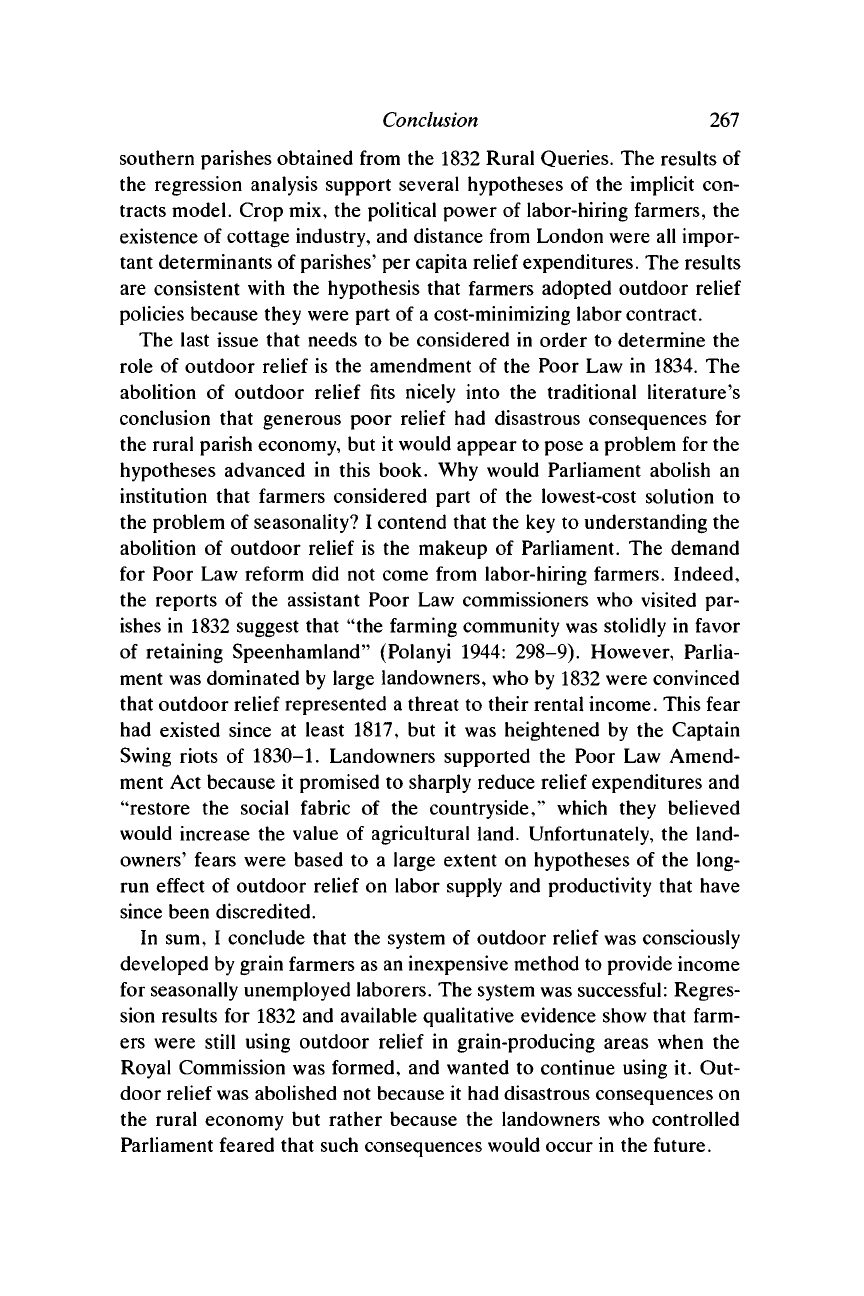
Conclusion 267
southern parishes obtained from the 1832 Rural Queries. The results of
the regression analysis support several hypotheses of the implicit con-
tracts model. Crop mix, the political power of labor-hiring farmers, the
existence of cottage industry, and distance from London were all impor-
tant determinants of parishes' per capita relief expenditures. The results
are consistent with the hypothesis that farmers adopted outdoor relief
policies because they were part of a cost-minimizing labor contract.
The last issue that needs to be considered in order to determine the
role of outdoor relief is the amendment of the Poor Law in 1834. The
abolition of outdoor relief fits nicely into the traditional literature's
conclusion that generous poor relief had disastrous consequences for
the rural parish economy, but it would appear to pose a problem for the
hypotheses advanced in this book. Why would Parliament abolish an
institution that farmers considered part of the lowest-cost solution to
the problem of seasonality? I contend that the key to understanding the
abolition of outdoor relief is the makeup of Parliament. The demand
for Poor Law reform did not come from labor-hiring farmers. Indeed,
the reports of the assistant Poor Law commissioners who visited par-
ishes in 1832 suggest that "the farming community was stolidly in favor
of retaining Speenhamland" (Polanyi 1944: 298-9). However, Parlia-
ment was dominated by large landowners, who by 1832 were convinced
that outdoor relief represented a threat to their rental income. This fear
had existed since at least 1817, but it was heightened by the Captain
Swing riots of
1830-1.
Landowners supported the Poor Law Amend-
ment Act because it promised to sharply reduce relief expenditures and
"restore the social fabric of the countryside," which they believed
would increase the value of agricultural land. Unfortunately, the land-
owners' fears were based to a large extent on hypotheses of the long-
run effect of outdoor relief on labor supply and productivity that have
since been discredited.
In sum, I conclude that the system of outdoor relief was consciously
developed by grain farmers as an inexpensive method to provide income
for seasonally unemployed laborers. The system was successful: Regres-
sion results for 1832 and available qualitative evidence show that farm-
ers were still using outdoor relief in grain-producing areas when the
Royal Commission was formed, and wanted to continue using it. Out-
door relief was abolished not because it had disastrous consequences on
the rural economy but rather because the landowners who controlled
Parliament feared that such consequences would occur in the future.

268 An Economic History of the English Poor Law
2.
The Old Poor Law in Perspective
Agricultural production is a long, discontinuous operation with periodic bouts of
hectic activities and intervals of relative idleness. Weather dependence not
merely makes the timing of each individual operation somewhat unpredictable,
it also means that when the time comes the job has to be done very quickly and
there are various risks and costs of delay. This implies that the employer is
usually keen on entering into some explicit or implicit contract with workers
about a dependable supply of labor at the right time. (Bardhan 1980: 92)
The problems created by seasonal fluctuations in the demand for
agricultural labor were not confined to early-nineteenth-century En-
gland. Seasonality is an inherent characteristic of arable agriculture that
continues to pose problems for farmers, particularly in developing coun-
tries.
However, the solution to seasonality that was adopted in early-
nineteenth-century England is unique: the systematic use of poor relief
to provide income for seasonally unemployed laborers.
1
One key to
understanding why English farmers chose to use outdoor relief is the
nature of the local tax system. Because taxpayers who did not hire labor
contributed to the poor rate, it was cheaper for farmers to lay off part of
their work force in slack seasons than to offer yearlong contracts to all
their workers or to provide workers with allotments of land or low-
interest consumption credit to get through slack seasons, alternatives
that Indian farmers provide today (Bardhan 1979: 488; Bardhan and
Rudra 1981: 96-111).
This does not mean, of course, that outdoor relief solved the problem
of seasonality. Grain-producing parishes still were plagued by a pool of
unemployed laborers each winter. It was in the interest of the parish to
find year-round employment for these seasonally unemployed workers.
There are two ways to reduce the seasonal underemployment of labor:
(1) to reduce the demand for agricultural labor during peak seasons, and
(2) to provide nonagricultural employment for seasonally unemployed
agricultural laborers. Before we can conclude that outdoor relief repre-
sented a cost-minimizing method for dealing with seasonality, we need
to consider whether its use slowed the adoption of policies to reduce
seasonality.
1
Joan Hannon (1984: 1030-1) found evidence of the payment of poor relief to seasonally
unemployed laborers in western New York during the 1850s. Additional research on
labor markets in grain-producing areas may reveal that the English solution to seasonality
was not unique.
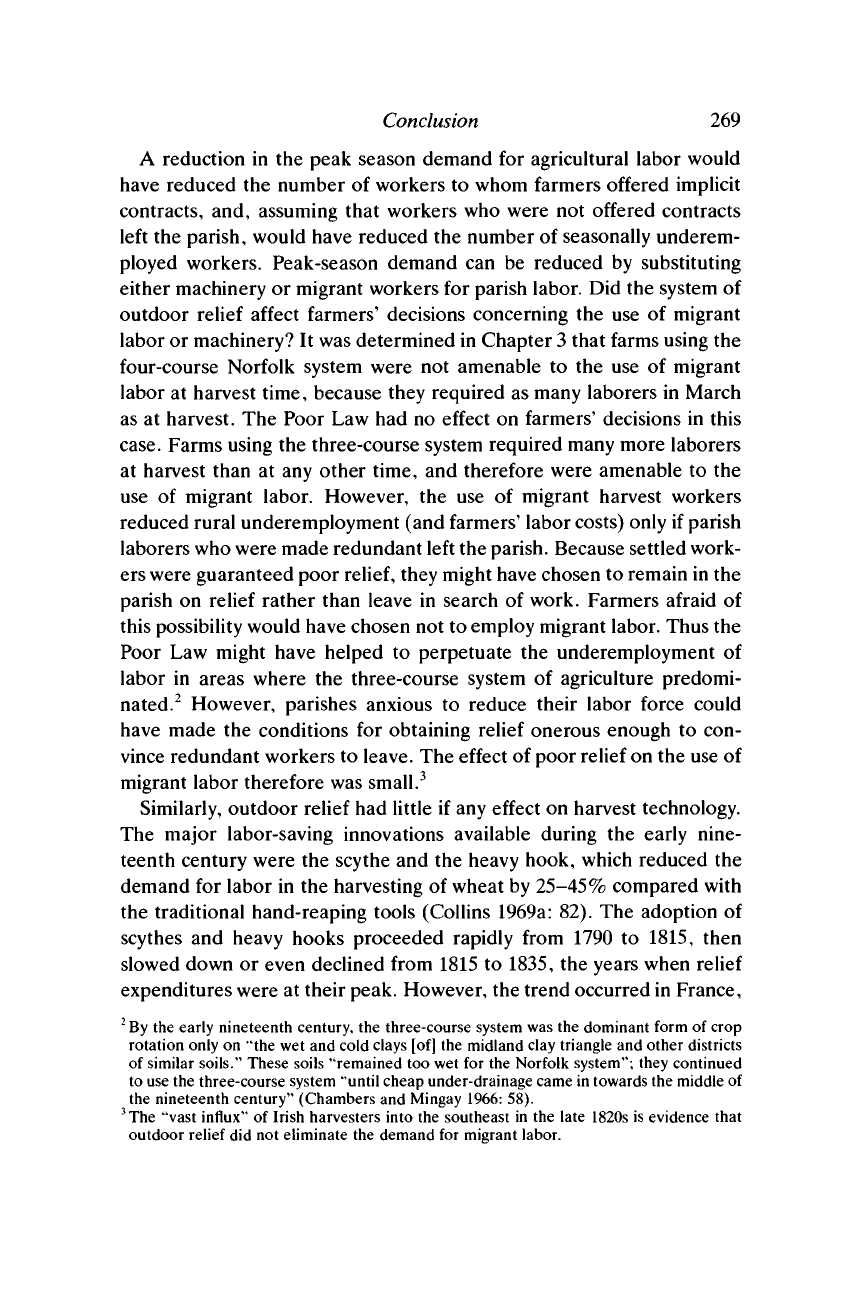
Conclusion 269
A reduction in the peak season demand for agricultural labor would
have reduced the number of workers to whom farmers offered implicit
contracts, and, assuming that workers who were not offered contracts
left the parish, would have reduced the number of seasonally underem-
ployed workers. Peak-season demand can be reduced by substituting
either machinery or migrant workers for parish labor. Did the system of
outdoor relief affect farmers' decisions concerning the use of migrant
labor or machinery? It was determined in Chapter
3
that farms using the
four-course Norfolk system were not amenable to the use of migrant
labor at harvest time, because they required as many laborers in March
as at harvest. The Poor Law had no effect on farmers' decisions in this
case.
Farms using the three-course system required many more laborers
at harvest than at any other time, and therefore were amenable to the
use of migrant labor. However, the use of migrant harvest workers
reduced rural underemployment (and farmers' labor costs) only if parish
laborers who were made redundant left the parish. Because settled work-
ers were guaranteed poor
relief,
they might have chosen to remain in the
parish on relief rather than leave in search of work. Farmers afraid of
this possibility would have chosen not to employ migrant labor. Thus the
Poor Law might have helped to perpetuate the underemployment of
labor in areas where the three-course system of agriculture predomi-
nated.
2
However, parishes anxious to reduce their labor force could
have made the conditions for obtaining relief onerous enough to con-
vince redundant workers to leave. The effect of poor relief on the use of
migrant labor therefore was small.
3
Similarly, outdoor relief had little if any effect on harvest technology.
The major labor-saving innovations available during the early nine-
teenth century were the scythe and the heavy hook, which reduced the
demand for labor in the harvesting of wheat by 25-45% compared with
the traditional hand-reaping tools (Collins 1969a: 82). The adoption of
scythes and heavy hooks proceeded rapidly from 1790 to 1815, then
slowed down or even declined from 1815 to 1835, the years when relief
expenditures were at their peak. However, the trend occurred in France,
2
By
the early nineteenth century, the three-course system was the dominant form of crop
rotation only on "the wet and cold clays [of] the midland clay triangle and other districts
of similar soils." These soils "remained too wet for the Norfolk system"; they continued
to use the three-course system "until cheap under-drainage came in towards the middle of
the nineteenth century" (Chambers and Mingay 1966: 58).
3
The
"vast influx" of Irish harvesters into the southeast in the late 1820s is evidence that
outdoor relief did not eliminate the demand for migrant labor.
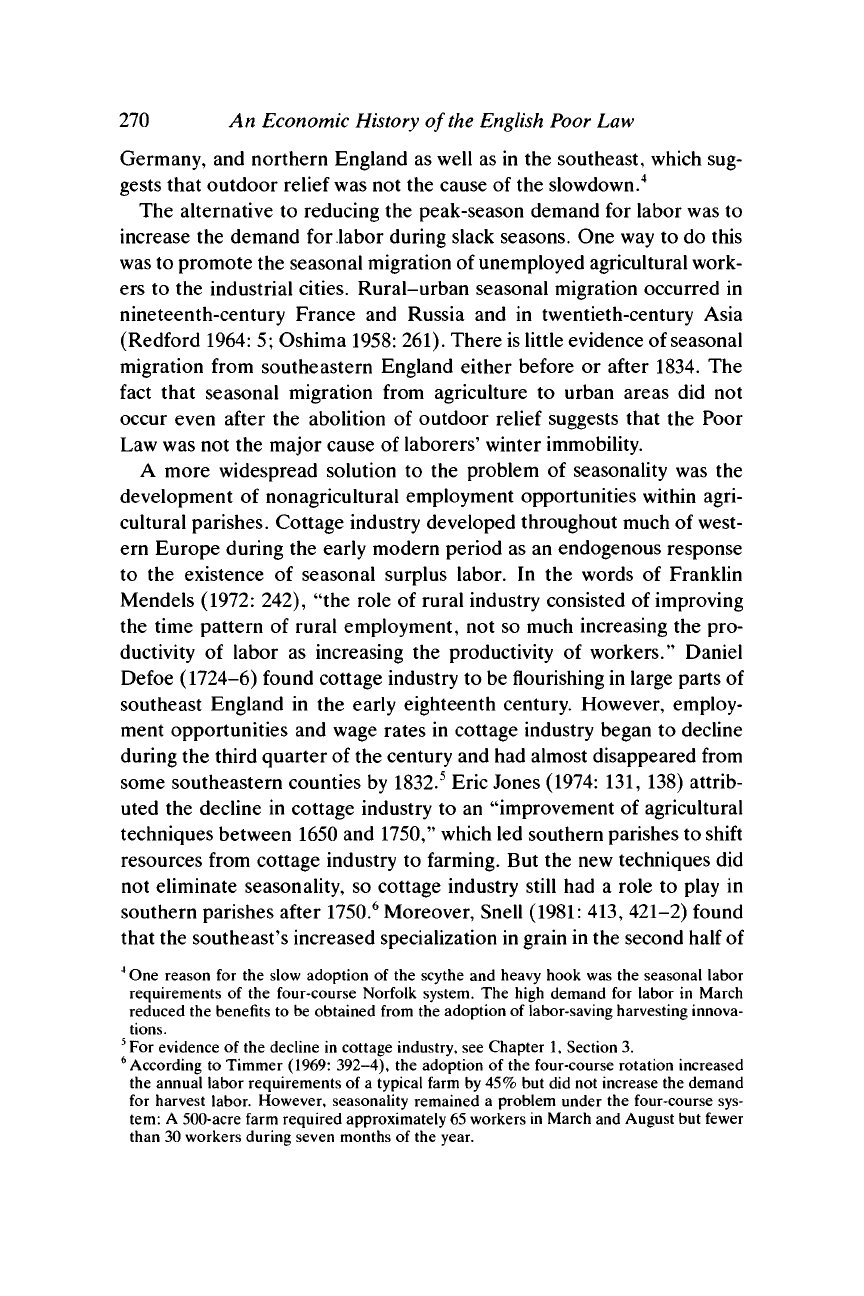
270 An Economic History of
the English Poor
Law
Germany, and northern England as well as in the southeast, which sug-
gests that outdoor relief was not the cause of the slowdown.
4
The alternative to reducing the peak-season demand for labor was to
increase the demand for labor during slack seasons. One way to do this
was to promote the seasonal migration of unemployed agricultural work-
ers to the industrial cities. Rural-urban seasonal migration occurred in
nineteenth-century France and Russia and in twentieth-century Asia
(Redford 1964: 5; Oshima
1958:
261). There is little evidence of seasonal
migration from southeastern England either before or after 1834. The
fact that seasonal migration from agriculture to urban areas did not
occur even after the abolition of outdoor relief suggests that the Poor
Law was not the major cause of laborers' winter immobility.
A more widespread solution to the problem of seasonality was the
development of nonagricultural employment opportunities within agri-
cultural parishes. Cottage industry developed throughout much of west-
ern Europe during the early modern period as an endogenous response
to the existence of seasonal surplus labor. In the words of Franklin
Mendels (1972: 242), "the role of rural industry consisted of improving
the time pattern of rural employment, not so much increasing the pro-
ductivity of labor as increasing the productivity of workers." Daniel
Defoe (1724-6) found cottage industry to be
flourishing
in large parts of
southeast England in the early eighteenth century. However, employ-
ment opportunities and wage rates in cottage industry began to decline
during the third quarter of the century and had almost disappeared from
some southeastern counties by 1832.
5
Eric Jones (1974: 131, 138) attrib-
uted the decline in cottage industry to an "improvement of agricultural
techniques between 1650 and 1750," which led southern parishes to shift
resources from cottage industry to farming. But the new techniques did
not eliminate seasonality, so cottage industry still had a role to play in
southern parishes after 1750.
6
Moreover, Snell
(1981:
413, 421-2) found
that the southeast's increased specialization in grain in the second half
of
4
One reason for the slow adoption of the scythe and heavy hook was the seasonal labor
requirements of the four-course Norfolk system. The high demand for labor in March
reduced the benefits to be obtained from the adoption of labor-saving harvesting innova-
tions.
5
For evidence of the decline in cottage industry, see Chapter 1, Section 3.
6
According to Timmer (1969: 392-4), the adoption of the four-course rotation increased
the annual labor requirements of a typical farm by
45%
but did not increase the demand
for harvest labor. However, seasonality remained a problem under the four-course sys-
tem: A 500-acre farm required approximately
65
workers in March and August but fewer
than 30 workers during seven months of the year.
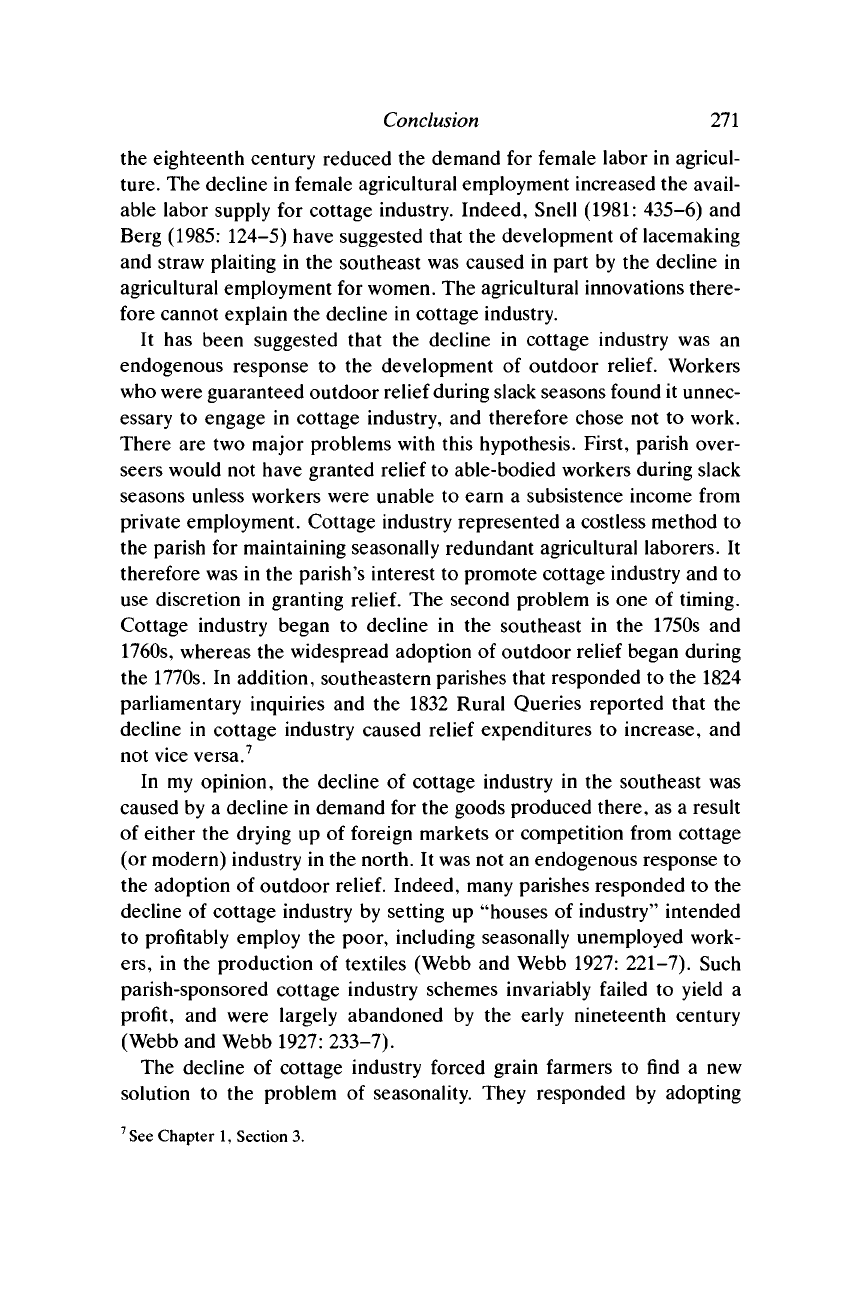
Conclusion
111
the eighteenth century reduced
the
demand
for
female labor
in
agricul-
ture.
The
decline
in
female agricultural employment increased
the
avail-
able labor supply
for
cottage industry. Indeed, Snell
(1981:
435-6)
and
Berg (1985: 124-5) have suggested that
the
development
of
lacemaking
and straw plaiting
in the
southeast
was
caused
in
part
by the
decline
in
agricultural employment
for
women.
The
agricultural innovations there-
fore cannot explain
the
decline
in
cottage industry.
It
has
been suggested that
the
decline
in
cottage industry
was an
endogenous response
to the
development
of
outdoor
relief.
Workers
who were guaranteed outdoor relief during slack seasons found
it
unnec-
essary
to
engage
in
cottage industry,
and
therefore chose
not to
work.
There
are two
major problems with this hypothesis. First, parish over-
seers would
not
have granted relief
to
able-bodied workers during slack
seasons unless workers were unable
to
earn
a
subsistence income from
private employment. Cottage industry represented
a
costless method
to
the parish
for
maintaining seasonally redundant agricultural laborers.
It
therefore
was in the
parish's interest
to
promote cottage industry
and to
use discretion
in
granting
relief. The
second problem
is one of
timing.
Cottage industry began
to
decline
in the
southeast
in the
1750s
and
1760s, whereas
the
widespread adoption
of
outdoor relief began during
the 1770s.
In
addition, southeastern parishes that responded
to the 1824
parliamentary inquiries
and the 1832
Rural Queries reported that
the
decline
in
cottage industry caused relief expenditures
to
increase,
and
not vice versa.
7
In
my
opinion,
the
decline
of
cottage industry
in the
southeast
was
caused
by a
decline
in
demand
for the
goods produced there,
as a
result
of either
the
drying
up of
foreign markets
or
competition from cottage
(or modern) industry
in the
north.
It
was
not an
endogenous response
to
the adoption
of
outdoor
relief.
Indeed, many parishes responded
to the
decline
of
cottage industry
by
setting
up
"houses
of
industry" intended
to profitably employ
the
poor, including seasonally unemployed work-
ers,
in the
production
of
textiles (Webb
and
Webb
1927:
221-7). Such
parish-sponsored cottage industry schemes invariably failed
to
yield
a
profit,
and
were largely abandoned
by the
early nineteenth century
(Webb
and
Webb 1927: 233-7).
The decline
of
cottage industry forced grain farmers
to
find
a new
solution
to the
problem
of
seasonality. They responded
by
adopting
7
See Chapter
1,
Section
3.
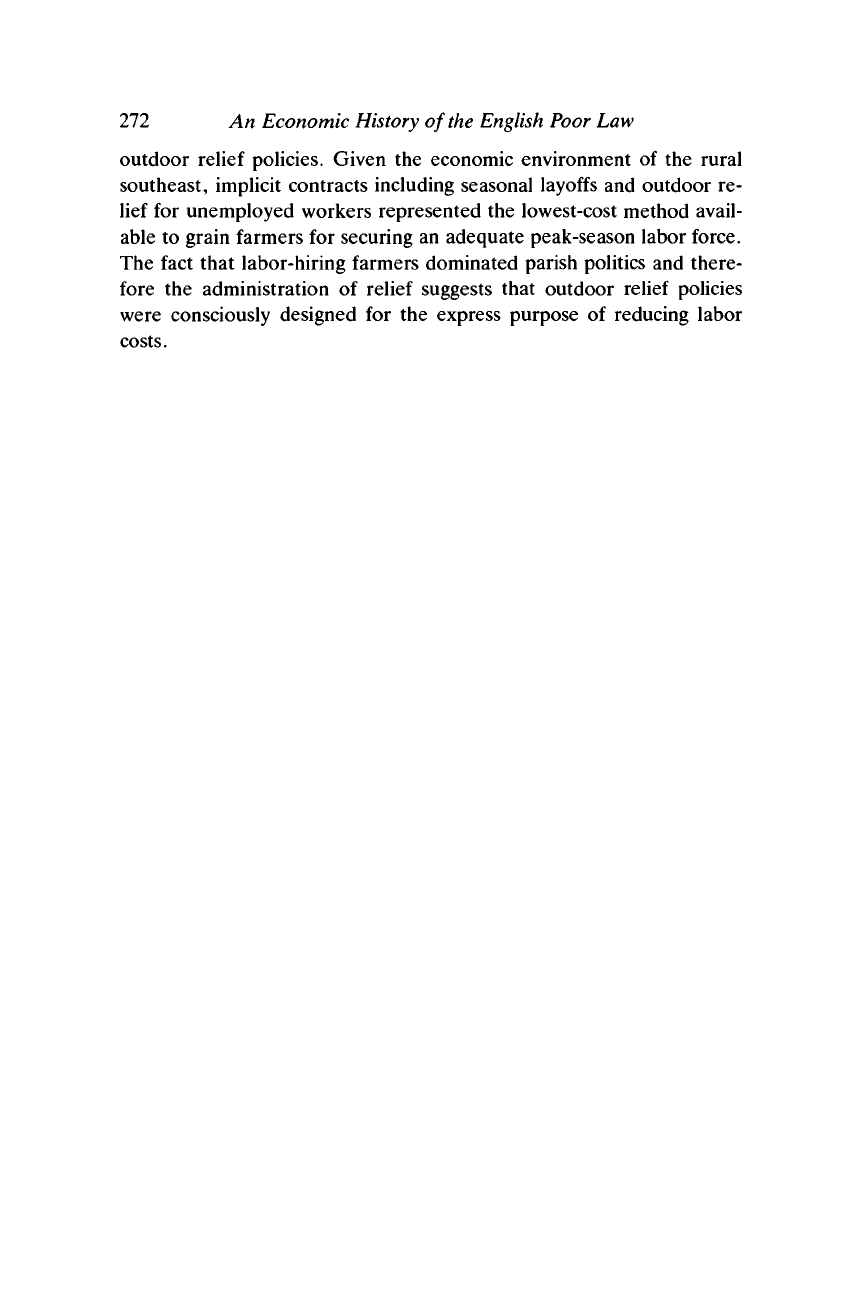
272 An Economic History of the
English Poor
Law
outdoor relief policies. Given the economic environment of the rural
southeast, implicit contracts including seasonal layoffs and outdoor re-
lief for unemployed workers represented the lowest-cost method avail-
able to grain farmers for securing an adequate peak-season labor force.
The fact that labor-hiring farmers dominated parish politics and there-
fore the administration of relief suggests that outdoor relief policies
were consciously designed for the express purpose of reducing labor
costs.
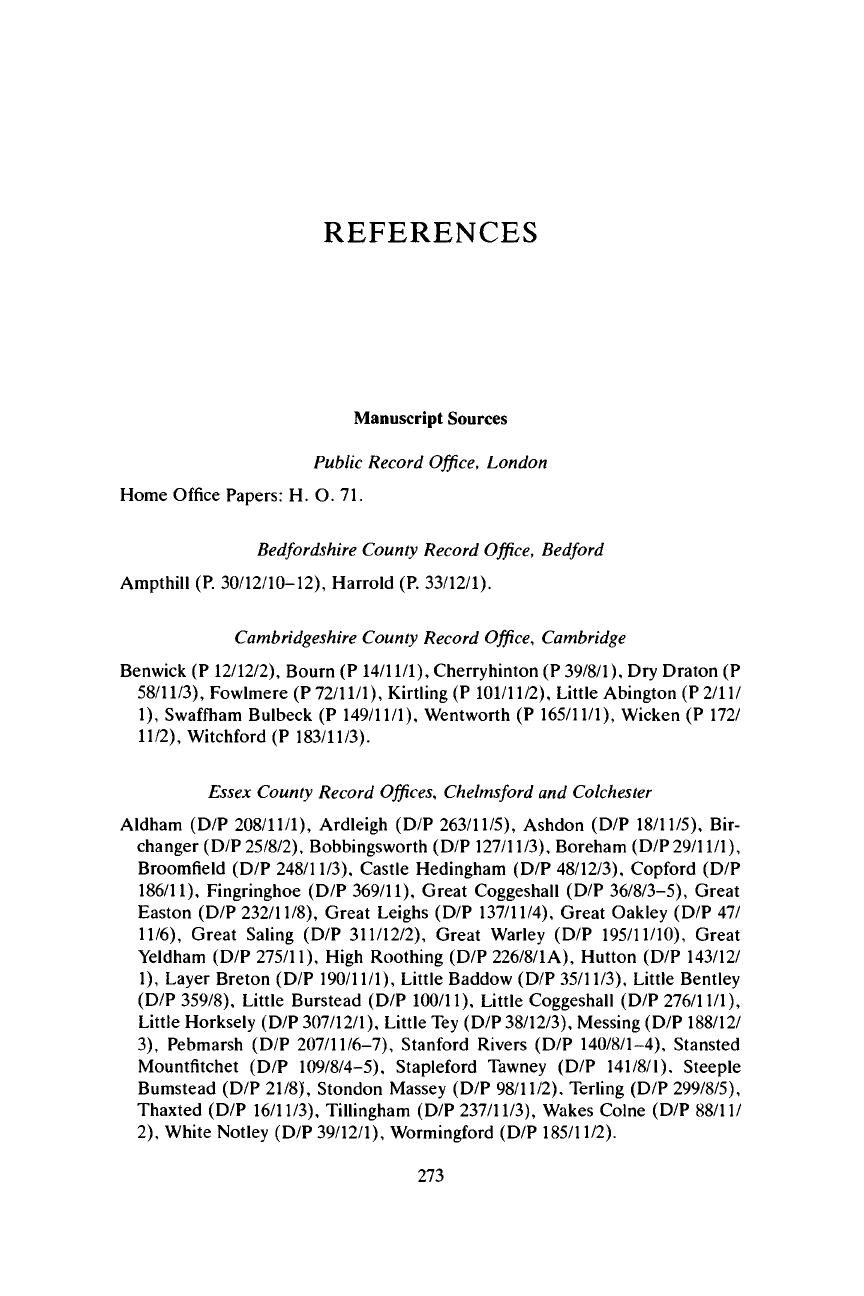
REFERENCES
Manuscript Sources
Public
Record
Office,
London
Home Office Papers: H. O. 71.
Bedfordshire
County Record
Office,
Bedford
Ampthill (P. 30/12/10-12), Harrold (P. 33/12/1).
Cambridgeshire
County Record
Office,
Cambridge
Benwick (P 12/12/2), Bourn (P 14/11/1), Cherryhinton (P 39/8/1), Dry Draton (P
58/11/3), Fowlmere (P 72/11/1), Kirtling (P 101/11/2), Little Abington (P
2/11/
1),
Swaffham Bulbeck (P 149/11/1), Wentworth (P 165/11/1), Wicken (P 172/
11/2),
Witchford (P 183/11/3).
Essex County Record
Offices,
Chelmsford
and
Colchester
Aldham (D/P 208/11/1), Ardleigh (D/P 263/11/5), Ashdon (D/P 18/11/5), Bir-
changer (D/P 25/8/2), Bobbingsworth (D/P 127/11/3), Boreham (D/P 29/11/1),
Broomfield (D/P 248/11/3), Castle Hedingham (D/P 48/12/3), Copford (D/P
186/11), Fingringhoe (D/P 369/11), Great Coggeshall (D/P 36/8/3-5), Great
Easton (D/P 232/11/8), Great Leighs (D/P 137/11/4), Great Oakley (D/P 47/
11/6),
Great Saling (D/P 311/12/2), Great Warley (D/P 195/11/10), Great
Yeldham (D/P 275/11), High Roothing (D/P 226/8/1
A),
Hutton (D/P 143/12/
1),
Layer Breton (D/P 190/11/1), Little Baddow (D/P 35/11/3), Little Bentley
(D/P 359/8), Little Burstead (D/P 100/11), Little Coggeshall (D/P 276/11/1),
Little Horksely (D/P 307/12/1), Little Tey (D/P 38/12/3), Messing (D/P 188/12/
3),
Pebmarsh (D/P 207/11/6-7), Stanford Rivers (D/P 140/8/1-4), Stansted
Mountfitchet (D/P 109/8/4-5), Stapleford Tawney (D/P 141/8/1), Steeple
Bumstead (D/P 21/8), Stondon Massey (D/P 98/11/2), Terling (D/P 299/8/5),
Thaxted (D/P 16/11/3), Tillingham (D/P 237/11/3), Wakes Colne (D/P
88/11/
2),
White Notley (D/P 39/12/1), Wormingford (D/P 185/11/2).
273
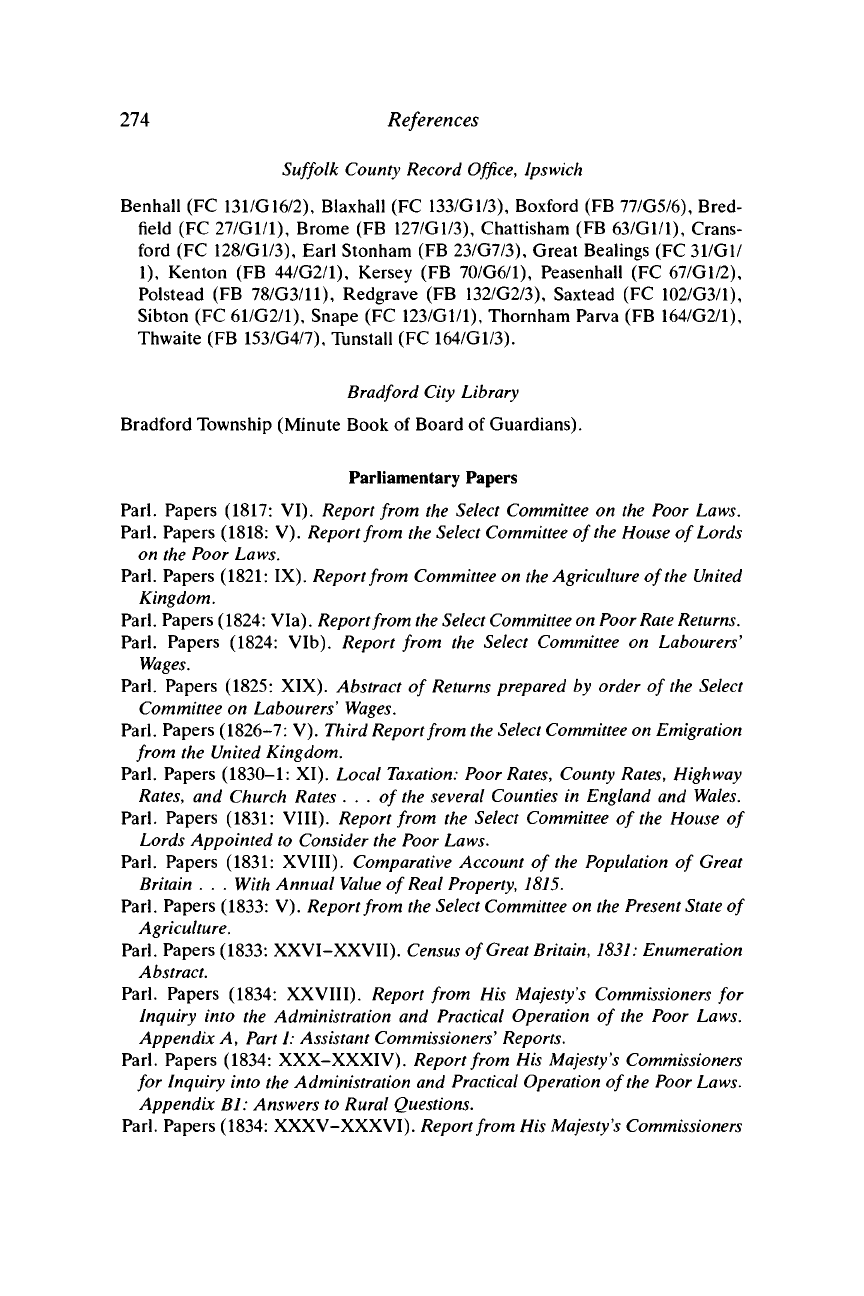
274 References
Suffolk County Record
Office,
Ipswich
Benhall (FC 131/G16/2), Blaxhall (FC 133/G1/3), Boxford (FB 77/G5/6), Bred-
field (FC 27/G1/1), Brome (FB 127/G1/3), Chattisham (FB 63/G1/1), Crans-
ford (FC 128/G1/3), Earl Stonham (FB 23/G7/3), Great Bealings (FC
31/G1/
1),
Kenton (FB 44/G2/1), Kersey (FB 70/G6/1), Peasenhall (FC 67/G1/2),
Polstead (FB 78/G3/11), Redgrave (FB 132/G2/3), Saxtead (FC 102/G3/1),
Sibton (FC 61/G2/1), Snape (FC 123/G1/1), Thornham Parva (FB 164/G2/1),
Thwaite (FB 153/G4/7), Tunstall (FC 164/G1/3).
Bradford
City
Library
Bradford Township (Minute Book of Board of Guardians).
Parliamentary Papers
Parl. Papers (1817: VI). Report from the Select Committee on the Poor Laws.
Parl. Papers (1818: V). Report from the
Select Committee
of
the
House of
Lords
on the
Poor
Laws.
Parl. Papers
(1821:
IX). Report from
Committee
on
the Agriculture
of the
United
Kingdom.
Parl. Papers
(1824:
Via). Report from
the Select Committee on Poor Rate
Returns.
Parl. Papers (1824: VIb). Report from the Select Committee on Labourers'
Wages.
Parl. Papers (1825: XIX). Abstract of
Returns
prepared by order of
the Select
Committee
on Labourers'
Wages.
Parl. Papers (1826-7: V).
Third
Report from
the Select Committee on Emigration
from the
United
Kingdom.
Parl. Papers
(1830-1:
XI). Local
Taxation:
Poor
Rates,
County
Rates,
Highway
Rates, and Church Rates . . . of
the several Counties
in England and
Wales.
Parl. Papers
(1831:
VIII). Report from the Select Committee of the House of
Lords Appointed to
Consider the Poor
Laws.
Parl. Papers
(1831:
XVIII).
Comparative
Account of the
Population
of
Great
Britain . . .
With
Annual
Value
of
Real
Property,
1815.
Parl. Papers
(1833:
V). Report from the
Select Committee
on the
Present State
of
Agriculture.
Parl. Papers
(1833:
XXVI-XXVII).
Census
of
Great
Britain,
1831:
Enumeration
Abstract.
Parl. Papers (1834: XXVIII). Report from His Majesty's
Commissioners
for
Inquiry into the Administration and
Practical
Operation of the Poor Laws.
Appendix A,
Part
I: Assistant
Commissioners'
Reports.
Parl. Papers (1834: XXX-XXXIV).
Report
from His
Majesty's Commissioners
for Inquiry into the
Administration
and
Practical Operation
of
the Poor
Laws.
Appendix Bl: Answers to Rural
Questions.
Parl. Papers (1834: XXXV-XXXVI). Report from His
Majesty's Commissioners
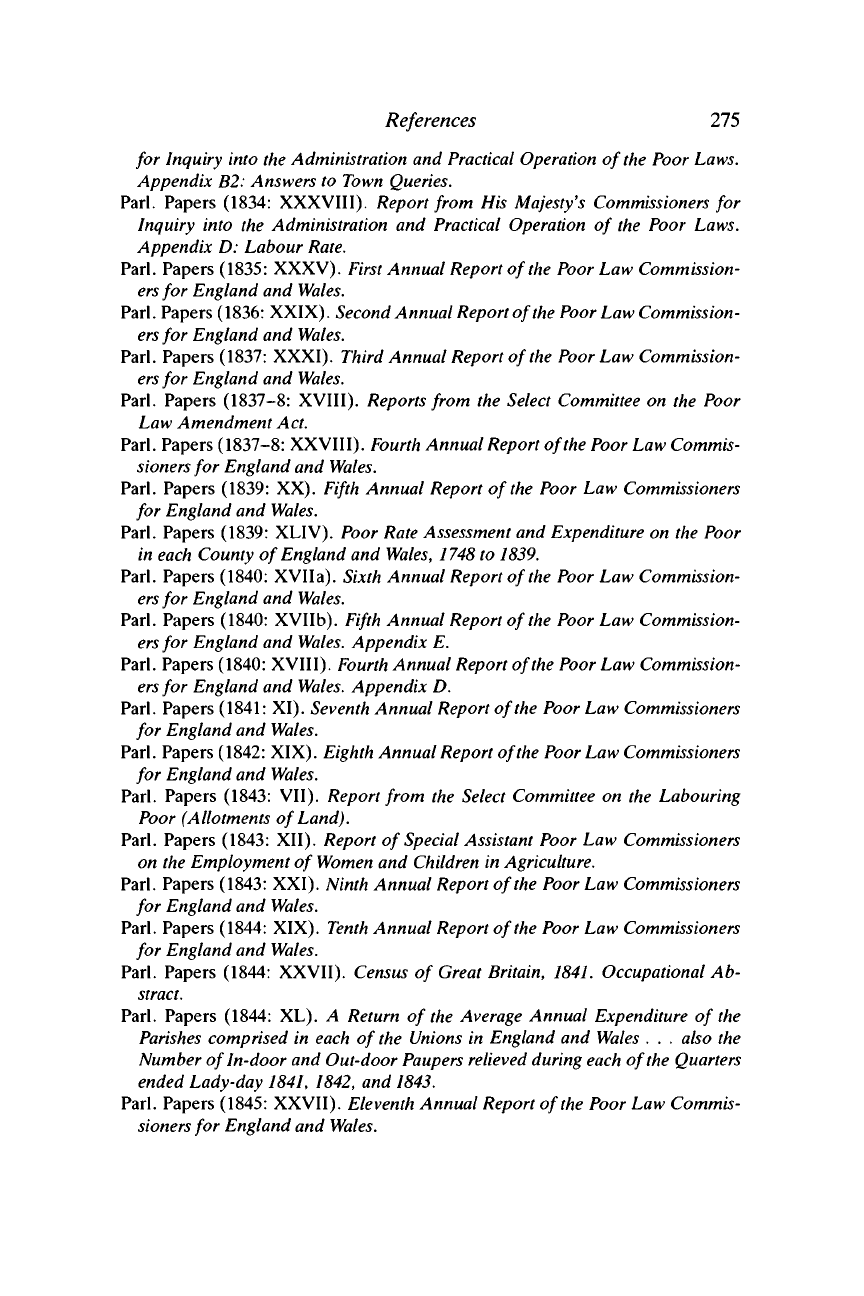
References 275
for Inquiry into the Administration and Practical Operation of the Poor Laws.
Appendix B2: Answers to Town Queries.
Parl. Papers (1834: XXXVIII). Report from His Majesty's Commissioners for
Inquiry into the Administration and Practical Operation of the Poor Laws.
Appendix D: Labour Rate.
Parl. Papers (1835: XXXV). First Annual Report of the Poor Law Commission-
ers
for England and Wales.
Parl. Papers (1836: XXIX). Second Annual Report of the Poor Law Commission-
ers
for England and Wales.
Parl. Papers (1837: XXXI). Third Annual Report of the Poor Law Commission-
ers
for England and Wales.
Parl. Papers (1837-8: XVIII). Reports from the Select Committee on the Poor
Law Amendment Act.
Parl. Papers (1837-8: XXVIII). Fourth Annual Report of the Poor Law Commis-
sioners for England and Wales.
Parl. Papers (1839: XX). Fifth Annual Report of the Poor Law Commissioners
for England and Wales.
Parl. Papers (1839: XLIV). Poor Rate Assessment and Expenditure on the Poor
in each County of England and Wales, 1748 to 1839.
Parl. Papers (1840: XVIIa). Sixth Annual Report of the Poor Law Commission-
ers
for England and Wales.
Parl. Papers (1840: XVIIb). Fifth Annual Report of the Poor Law Commission-
ers
for England and Wales. Appendix E.
Parl. Papers (1840: XVIII). Fourth Annual Report of the Poor Law Commission-
ers
for England and Wales. Appendix D.
Parl. Papers
(1841:
XI). Seventh Annual Report of the Poor Law Commissioners
for England and Wales.
Parl. Papers (1842: XIX). Eighth Annual Report of the Poor Law Commissioners
for England and Wales.
Parl. Papers
(1843:
VII). Report from the Select Committee on the Labouring
Poor (Allotments of Land).
Parl. Papers
(1843:
XII). Report of Special Assistant Poor Law Commissioners
on the Employment of Women and Children in Agriculture.
Parl. Papers
(1843:
XXI). Ninth Annual Report of the Poor Law Commissioners
for England and Wales.
Parl. Papers (1844: XIX). Tenth Annual Report of the Poor Law Commissioners
for England and Wales.
Parl. Papers (1844: XXVII). Census of Great Britain, 1841. Occupational Ab-
stract.
Parl. Papers (1844: XL). A Return of the Average Annual Expenditure of the
Parishes comprised in each of the Unions in England and Wales . . . also the
Number of In-door and Out-door Paupers relieved during each of the Quarters
ended Lady-day 1841, 1842, and 1843.
Parl. Papers (1845: XXVII). Eleventh Annual Report of the Poor Law Commis-
sioners for England and Wales.
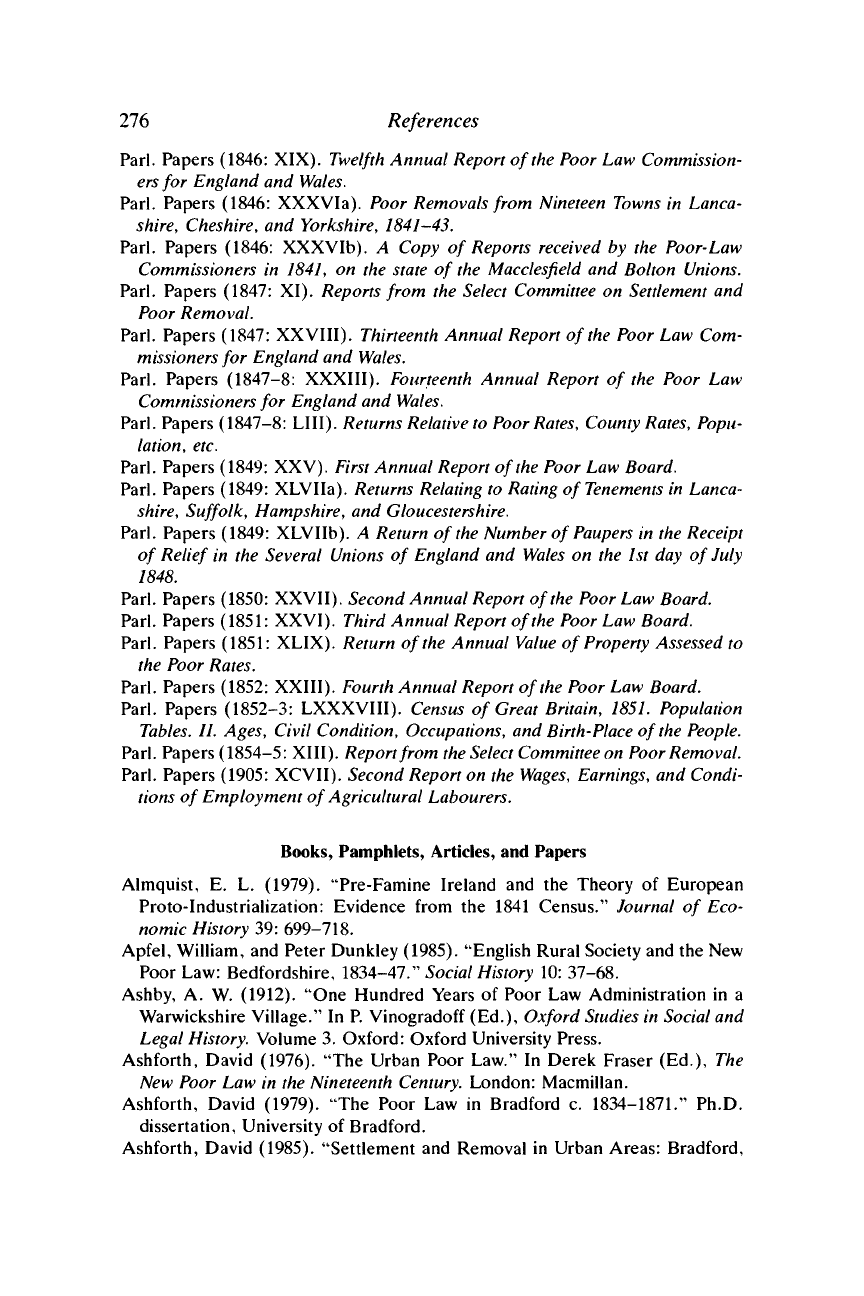
276 References
Parl. Papers (1846: XIX).
Twelfth
Annual Report of
the Poor
Law
Commission-
ers
for England and
Wales.
Parl. Papers (1846: XXXVIa). Poor
Removals
from
Nineteen Towns
in Lanca-
shire,
Cheshire,
and
Yorkshire,
1841-43.
Parl. Papers (1846: XXXVIb). A Copy of
Reports received
by the Poor-Law
Commissioners in 1841, on the state of the
Macclesfield
and Bolton Unions.
Parl. Papers (1847: XI). Reports from the Select Committee on
Settlement
and
Poor
Removal.
Parl. Papers (1847: XXVIII).
Thirteenth
Annual Report of
the
Poor Law Com-
missioners
for England and
Wales.
Parl. Papers (1847-8: XXXIII).
Fourteenth
Annual Report of the Poor Law
Commissioners
for England and
Wales.
Parl. Papers (1847-8: LIII).
Returns Relative
to
Poor
Rates,
County
Rates,
Popu-
lation, etc.
Parl. Papers (1849: XXV).
First
Annual Report of the
Poor
Law
Board.
Parl. Papers (1849: XLVIIa).
Returns Relating
to
Rating
of
Tenements
in Lanca-
shire,
Suffolk,
Hampshire, and
Gloucestershire.
Parl. Papers (1849: XLVIIb). A Return of
the
Number of
Paupers
in the
Receipt
of Relief in the Several
Unions
of England and
Wales
on the 1st day of
July
1848.
Parl. Papers (1850: XXVII). Second Annual Report of
the Poor
Law
Board.
Parl. Papers
(1851:
XXVI).
Third
Annual Report of
the Poor
Law
Board.
Parl. Papers
(1851:
XLIX). Return of
the
Annual
Value
of
Property Assessed
to
the
Poor
Rates.
Parl. Papers (1852: XXIII).
Fourth
Annual Report of
the Poor
Law
Board.
Parl. Papers (1852-3: LXXXVIII). Census of
Great
Britain,
1851. Population
Tables.
11.
Ages, Civil
Condition,
Occupations,
and
Birth-Place
of
the
People.
Parl. Papers (1854-5: XIII). Report from
the Select Committee on Poor
Removal.
Parl. Papers (1905: XCVII). Second Report on the
Wages,
Earnings,
and
Condi-
tions of Employment of
Agricultural
Labourers.
Books, Pamphlets, Articles, and Papers
Almquist, E. L. (1979). "Pre-Famine Ireland and the Theory of European
Proto-Industrialization: Evidence from the 1841 Census." Journal of Eco-
nomic History 39: 699-718.
Apfel, William, and Peter Dunkley (1985). "English Rural Society and the New
Poor Law: Bedfordshire, 1834-47."
Social History
10: 37-68.
Ashby, A. W. (1912). "One Hundred Years of Poor Law Administration in a
Warwickshire Village." In P. Vinogradoff (Ed.), Oxford
Studies
in
Social and
Legal
History.
Volume 3. Oxford: Oxford University Press.
Ashforth, David (1976). "The Urban Poor Law." In Derek Fraser (Ed.), The
New Poor Law in the
Nineteenth
Century.
London: Macmillan.
Ashforth, David (1979). "The Poor Law in Bradford c. 1834-1871." Ph.D.
dissertation, University of Bradford.
Ashforth, David (1985). "Settlement and Removal in Urban Areas: Bradford,
